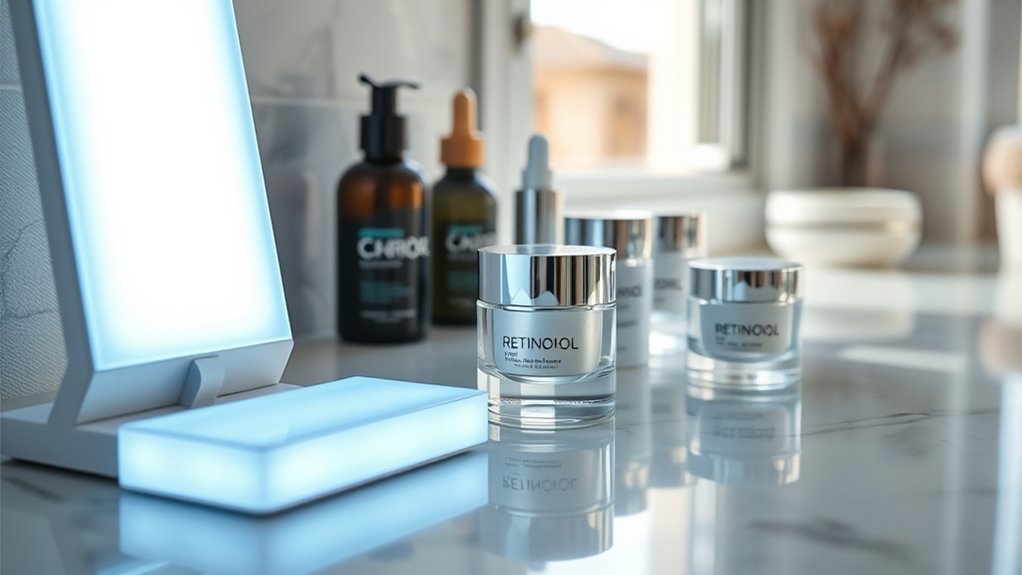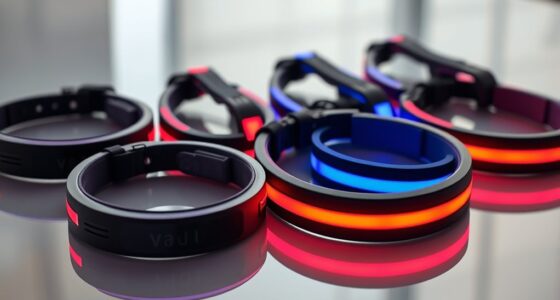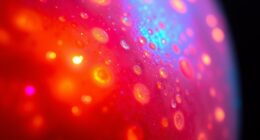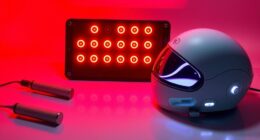LED light therapy doesn’t replace retinol, but it can work alongside it to improve your skin. While retinol boosts cell turnover and targets signs of aging, LED treatments promote collagen and reduce inflammation. Combining both creates a balanced routine that enhances skin renewal without overloading your skin. If you’re interested in tailored tips on how to integrate these treatments safely, continue exploring the best way to optimize your skincare routine.
Key Takeaways
- LED light therapy and retinol target different skin concerns; LED enhances healing and collagen, retinol accelerates cell turnover and anti-aging.
- LED therapy does not replace retinol’s potent anti-aging benefits but complements it for overall skin renewal.
- A hybrid routine involves using retinol at night and scheduling LED sessions to maximize benefits while minimizing irritation.
- Combining both requires caution due to retinol’s light sensitivity; sunscreen and proper skin monitoring are essential.
- A dermatologist can help tailor a safe, effective hybrid routine to address multiple skin concerns simultaneously.
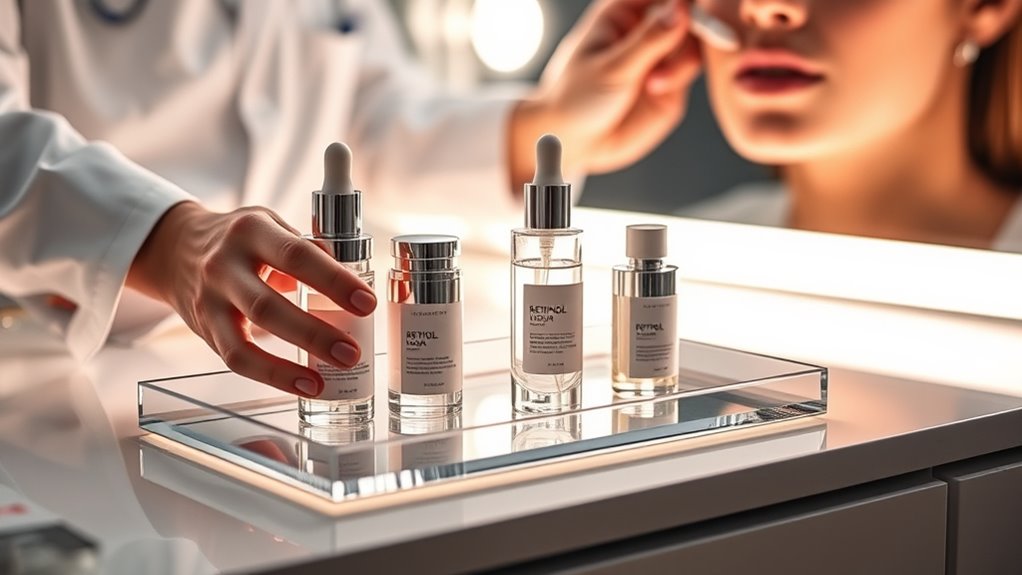
Combining LED light therapy with retinol can enhance your skincare routine by addressing multiple skin concerns simultaneously. These two treatments work differently but complement each other well, especially when it comes to skin rejuvenation and anti-aging benefits. LED light therapy uses specific wavelengths of light to stimulate cellular activity, boost collagen production, and reduce inflammation. It’s a gentle, non-invasive way to improve skin texture, tone, and overall radiance. Retinol, on the other hand, is a potent derivative of vitamin A that accelerates cell turnover, diminishes fine lines, and minimizes age spots. When used together, they create a powerful synergy that can considerably enhance your skin’s appearance.
While some may wonder if LED light therapy can replace retinol, the truth is that each offers unique benefits. LED therapy is excellent for reducing redness, calming sensitive skin, and promoting skin healing, but it doesn’t have the same potent anti-aging effects as retinol. Retinol penetrates deeper layers of the skin, stimulating new collagen and elastin fibers that are essential for maintaining firmness and elasticity. It’s particularly effective at targeting stubborn signs of aging, such as deep wrinkles and uneven pigmentation. Combining these treatments allows you to target multiple concerns at once without overloading your skin with aggressive ingredients or procedures.
A hybrid routine involves applying retinol in your evening skincare regimen, after cleansing and toning. You’ll want to start with a low concentration and gradually increase as tolerated to prevent irritation. On alternate nights or as recommended by your dermatologist, you can incorporate LED light therapy sessions, either at a clinic or with an at-home device. Using LED therapy regularly helps maintain skin rejuvenation and supports the collagen-boosting effects triggered by retinol. This combination ensures your skin is continuously stimulated for renewal, resulting in a more youthful, vibrant appearance over time.
Additionally, understanding the different wavelengths of light used in LED therapy can help you select the right treatments for your specific skin concerns. It’s important to remember that combining these treatments requires some caution. Retinol can make your skin more sensitive to light, so always apply a broad-spectrum sunscreen during the day. Also, listen to your skin’s response—if you notice irritation or excessive dryness, scale back the frequency of retinol use or consult your dermatologist. Overall, a well-planned hybrid routine leverages the strengths of both LED light therapy and retinol, allowing you to achieve extensive skin rejuvenation and anti-aging benefits without unnecessary risks. This approach offers a balanced, effective pathway to healthier, more youthful skin.
Frequently Asked Questions
Can LED Therapy Improve Deep Wrinkles and Sagging Skin?
LED therapy can help improve deep wrinkles and sagging skin by stimulating collagen production, thanks to recent photorejuvenation advancements. When comparing LED devices, look for those with proven safety and efficacy for targeting deeper skin layers. While LED therapy offers visible improvements, it works best when combined with other treatments. Consistent sessions can boost skin firmness over time, making it a valuable addition to your anti-aging routine.
How Often Should I Use LED Light Treatments for Optimal Results?
You should follow the frequency guidelines for LED light treatments to see ideal results. Typically, scheduling treatments 2-3 times per week works well for most skin concerns. Consistency is key, so stick to your routine and give your skin time to respond. Adjust treatment scheduling based on your dermatologist’s advice, especially if you notice improvement or any irritation. Regular sessions help maximize benefits and maintain your glow.
Are There Any Side Effects From Combining Retinol With LED Therapy?
When you combine retinol with LED therapy, watch out for retinol sensitivity, which can cause redness or irritation. Also, LED overheating could increase your risk of skin discomfort or damage. To reduce side effects, start with lower retinol concentrations and shorter LED sessions, and always listen to your skin’s reactions. Consulting a dermatologist helps ensure your hybrid routine is safe and effective, reducing potential adverse effects.
What Skin Types Benefit Most From LED and Retinol Hybrid Routines?
If you have sensitive or oily skin, a hybrid routine with LED and retinol can work well. Sensitive skin benefits from LED’s gentle, calming effects while retinol helps with cell turnover. Oily skin can enjoy the oil-control benefits of retinol combined with LED’s ability to reduce inflammation and redness. This combination promotes clearer, healthier skin, but always start slowly to see how your skin responds.
Is Professional LED Treatment More Effective Than At-Home Devices?
Think of professional LED treatments like a high-performance sports car—more powerful and precise—while at-home devices are like a reliable bike. Professional LED offers deeper, targeted results, often backed by clinical data, making it more effective for stubborn skin issues. However, at-home devices are convenient and improve over time. If you want faster, noticeable results, investing in professional LED is worth it; otherwise, at-home options still provide great benefits.
Conclusion
So, as you explore your skincare routine, remember that sometimes, a little coincidence can lead to great results. Just like discovering that your favorite LED mask perfectly complements your retinol nights, blending these treatments might give you the glow you’ve been chasing. Trust your skin’s story, and don’t be surprised if, in the end, it’s the unexpected combination that brings out your best. After all, skincare is as much about discovery as it is about routine.
